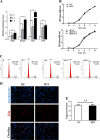LncRNA H19 promotes the committed differentiation of stem cells from apical papilla via miR-141/SPAG9 pathway
- PMID: 30755596
- PMCID: PMC6372621
- DOI: 10.1038/s41419-019-1337-3
LncRNA H19 promotes the committed differentiation of stem cells from apical papilla via miR-141/SPAG9 pathway
Abstract
Long noncoding RNAs (lncRNAs) exert significant roles at transcriptional and post-transcriptional levels. Stem cells from apical papilla (SCAPs) differentiate into dentin/bone-like tissues under certain conditions. So far, whether lncRNA-H19 can affect the proliferative behaviors and osteo/odontogenesis of SCAPs, as well as its specific mechanism remain to be elucidated. Here, SCAPs were isolated and transfected with the lentiviruses or packaging vectors. Our results showed that lncRNA-H19 had no significant effect on the proliferative behaviors of SCAPs, as presented by CCK-8 assay, EdU assay and flow cytometry (FCM). Furthermore, alkaline phosphatase (ALP) activity, alizarin red staining, Western blot assay (WB), quantitative real-time polymerase chain reaction (qRT-PCR) and in vivo bone formation assay were conducted to verify the biological influences of H19 on SCAPs. Overexpression of H19 led to the enhanced osteo/odontogenesis of SCAPs, whereas knockdown of H19 inhibited these effects. Mechanistically, H19 competitively bound to miR-141 and prevented SPAG9 from miRNA-mediated degradation, thus significantly elevating phosphorylated levels of p38 and JNK and facilitating the committed differentiation of SCAPs. Taken together, the osteo/odontogenesis of SCAPs was upregulated by overexpression of H19 via miR-141/SPAG9 pathway.
Conflict of interest statement
The authors declare that they have no conflict of interest.
Figures







Similar articles
-
MicroRNA hsa-let-7b suppresses the odonto/osteogenic differentiation capacity of stem cells from apical papilla by targeting MMP1.J Cell Biochem. 2018 Aug;119(8):6545-6554. doi: 10.1002/jcb.26737. Epub 2018 May 8. J Cell Biochem. 2018. PMID: 29384216
-
IGF-1/IGF-1R/hsa-let-7c axis regulates the committed differentiation of stem cells from apical papilla.Sci Rep. 2016 Nov 11;6:36922. doi: 10.1038/srep36922. Sci Rep. 2016. PMID: 27833148 Free PMC article.
-
The Effects of Mitogen-activated Protein Kinase Signaling Pathways on Lipopolysaccharide-mediated Osteo/Odontogenic Differentiation of Stem Cells from the Apical Papilla.J Endod. 2019 Feb;45(2):161-167. doi: 10.1016/j.joen.2018.10.009. J Endod. 2019. PMID: 30711172
-
Stem Cells from the Apical Papilla: A Promising Source for Stem Cell-Based Therapy.Biomed Res Int. 2019 Jan 29;2019:6104738. doi: 10.1155/2019/6104738. eCollection 2019. Biomed Res Int. 2019. PMID: 30834270 Free PMC article. Review.
-
The role and mechanism of long non-coding RNA H19 in stem cell osteogenic differentiation.Mol Med. 2021 Aug 12;27(1):86. doi: 10.1186/s10020-021-00350-y. Mol Med. 2021. PMID: 34384352 Free PMC article. Review.
Cited by
-
Identification and in vitro validation of prognostic lncRNA signature in head and neck squamous cell carcinoma.Bioengineered. 2021 Dec;12(2):10049-10062. doi: 10.1080/21655979.2021.1995577. Bioengineered. 2021. PMID: 34872450 Free PMC article.
-
Characterizing miRNA-lncRNA Interplay.Methods Mol Biol. 2021;2372:243-262. doi: 10.1007/978-1-0716-1697-0_21. Methods Mol Biol. 2021. PMID: 34417757
-
Molecular therapies delaying cardiovascular aging: disease- or health-oriented approaches.Vasc Biol. 2020 Jan 16;2(1):R45-R58. doi: 10.1530/VB-19-0029. eCollection 2020. Vasc Biol. 2020. PMID: 32923974 Free PMC article. Review.
-
Epigenetic regulation of dental-derived stem cells and their application in pulp and periodontal regeneration.PeerJ. 2023 Jan 3;11:e14550. doi: 10.7717/peerj.14550. eCollection 2023. PeerJ. 2023. PMID: 36620748 Free PMC article. Review.
-
Clinical Perspectives of Non-Coding RNA in Oral Inflammatory Diseases and Neuropathic Pain: A Narrative Review.Int J Mol Sci. 2022 Jul 27;23(15):8278. doi: 10.3390/ijms23158278. Int J Mol Sci. 2022. PMID: 35955417 Free PMC article. Review.
References
Publication types
MeSH terms
Substances
LinkOut - more resources
Full Text Sources
Medical
Research Materials

